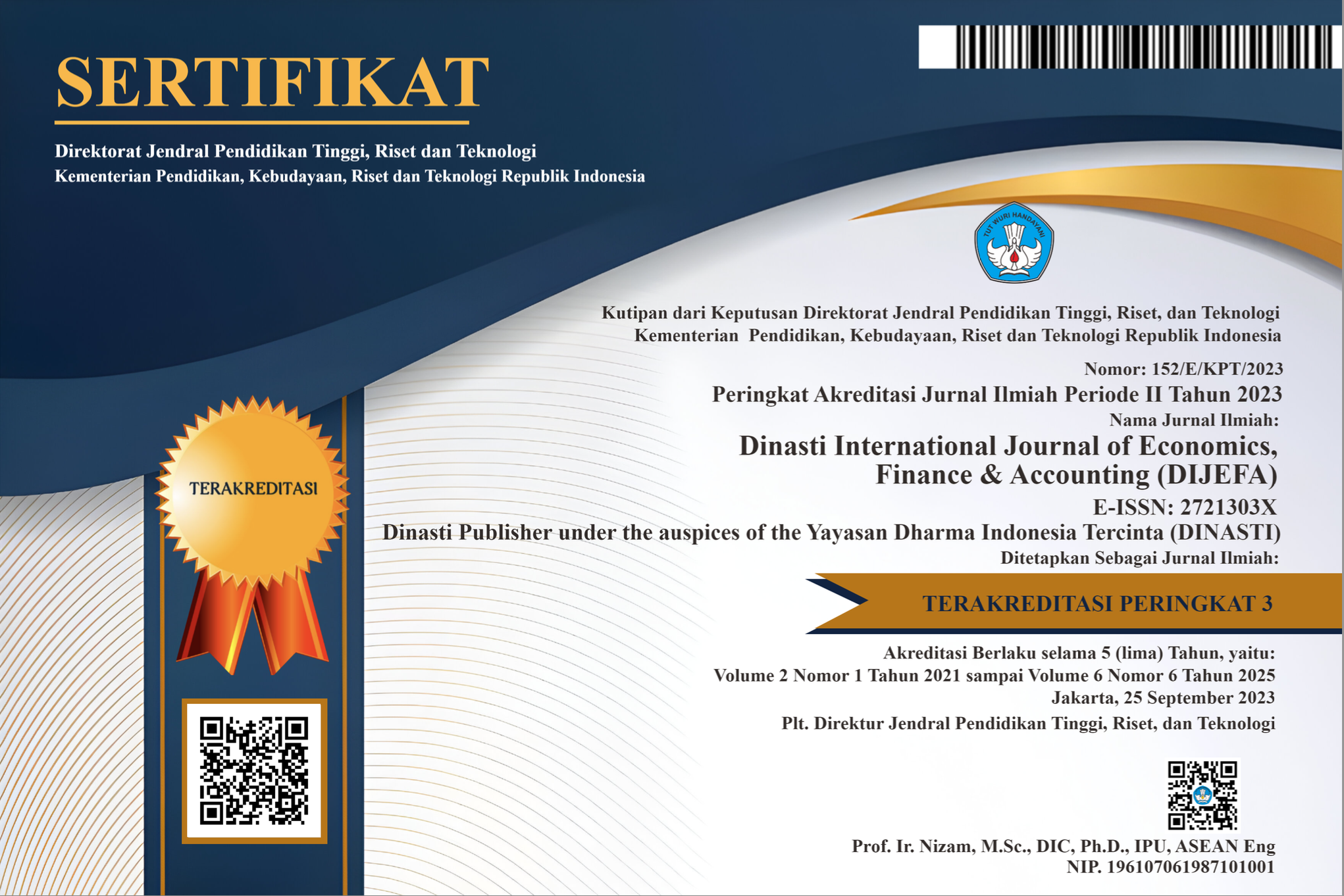Impact of Days to Receivable on the Profitability of Exporting Coal Companies in Indonesia
DOI:
https://doi.org/10.38035/dijefa.v5i4.3410Keywords:
account receivable, export, exchange rate, working capital management, profitabilityAbstract
This study examines the effects of exchange rates, export intensity, and days to receivable on the profitability of Indonesian coal exporting companies, using panel data from 2015 to 2023. The objective is to find if export intensity and exchange rate impedes the effect of days to receivable on profitability. Interaction analyses reveal that the positive impact of receivables on profitability diminishes with increasing exchange rates. Conversely, the interaction between days to receivable and export intensity does not significantly affect profitability. Therefore, it might be beneficial for Indonesian coal companies should explore implementing more flexible trade credit policies to enhance customer relationships, particularly during periods of rupiah appreciation.
References
Abor, J. (2011). Do export status and export intensity increase firm performance?. Thunderbird International Business Review, 53(1), 9-18.
Adams, P., & Verdelhan, A. (2022). Exchange rate risk in public firms. Working paper, MIT Sloan.
Ahmad, K. K., Salih, K. H., & Sangawi, S. S. (2024). The Impact of Operating Cash Flow on Corporate Profitability: Amman Stock Exchange case study. Journal of Economics and Administrative Sciences, 30(140), 532-543.
Aldubhani, M. A., Wang, J., Gong, T., & Maudhah, R. A. (2022). Impact of working capital management on profitability: evidence from listed companies in Qatar. Journal of Money and Business, 2(1), 70-81.
Azmi, A., Adam, M., Widiyanti, M., & Malinda, S. (2022). Impact of US Dollar Exchange Rate and Inflation on Profitability. International Research Journal of Management, IT & Social Sciences, 9(1), 131-137.
Basyith, A., Djazuli, A., & Fauzi, F. (2021). Does working capital management affect profitability? Empirical evidence from Indonesia listed firms. Asian Economic and Financial Review, 11(3), 236-251.
Bui, M. T., & Nguyen, H. M. (2020). Determinants Affecting Profitability of Firms: A Study of Oil and Gas Industry in Vietnam. Journal of Asian Finance, Economics and Business, 8(1), 599-608.
Choi, S. (2020). Currency valuation, export competitiveness, and firm profitability: Evidence from Bangladeshi firm-level data. Journal of Asian Finance, Economics and Business, 8(1), 61-69.
Clavero, B. (2021). Hedging of currency exposures: Lessons for SME exporters and importers. Available at SSRN 3956012.
Duman, F. (2017). Working capital management and the impact of fluctuating exchange rates (Master's thesis). Çankaya University, Graduate School of Social Sciences, Department of International Trade and Finance.
Huong, T. T. T. (2021). Operating Cash Flow And Corporate Financial Performance Of Listed Companies In Vietnam. Proceeding of 13th NEU-KKU International Conference on Socio-Economic and Environmental Issues in Development.
Mahor, N., & Banerji, A. (2023). Profitability Study of Indian Pharmaceutical Industry: A Co-Integration Approach. Journal of Scientific and Industrial Research, 82(9), 973-982. doi:10.56042/jsir.v82i9.2180
Ogada, A. J., Wagude, J., & Odada, J. E. (2021). Does Average Collection Period affect Profitability of Manufacturing and Allied companies listed on NSE?.
Paiva, L. C. A. C. (2020). Do international activities influence firms' profitability? The case of the Portuguese furniture industry (Master's dissertation). Universidade do Porto, Faculdade de Economia.
Rosdiana, R. (2021). Analysis of the Effect of Stock Prices on Coal Sub-Sector on the Indonesia Stock Exchange 2014-2019. Dinasti International Journal of Economics, Finance & Accounting, 2(5), 528-539.
Ruslan, Z., & Nugroho, A. B. (2022). Collectibility Improvement in PT. Kaltim Prima Coal Receivables Management: A Framework Roadmap Proposal. Jurnal sosial dan sains, 2(1), 149-158.
Sierpi?ska, M. (2020). Coal Companies’ Trade Credit Policy. In?ynieria Mineralna, 1(1), 231-236.
Sierpi?ska-Sawicz, A. (2021). Liquidity measurement problems in mining companies. Journal of the Polish Mineral Engineering Society, 105-111. doi:10.29277/IM-2021-01-14
Talukder, B., & Tripathi, S. (2021). Impact of supply chain performance on firms' export capability: Development of a statistical model. Global Business Review. https://doi.org/10.1177/09721509211043403
Bellouma, M. (2011). The impact of working capital management on profitability: The case of small and medium-sized export companies in Tunisia. Management International, 15(3). https://doi.org/10.7202/1005434ar rg/10.1177/09721509211043403
Vu, H., Holmes, M., Lim, S., & Tran, T. (2014). Exports and profitability: A note from quantile regression approach. Applied Economics Letters, 21(6), 442-445. https://doi.org/10.1080/13504851.2013.866197
Wahyuni, F., Alie, M. S., Novalita, S. E., & Ak, M. S. (2022, October). The Effect Of Debt Level And Cash Flow On Profit Persistency Of Coal Mining Sub-Sector Listed On Indonesia Stock Exchange Period 2017-2021. In Proceedings (Vol. 1, No. 3, pp. 38-51).
Downloads
Published
How to Cite
Issue
Section
License
Copyright (c) 2024 Putri Andari Ferranti, Anton Hindardjo

This work is licensed under a Creative Commons Attribution 4.0 International License.
Authors who publish their manuscripts in this journal agree to the following conditions:
- The copyright on each article belongs to the author(s).
- The author acknowledges that the Dinasti International Journal of Economics, Finance & Accounting (DIJEFA) has the right to be the first to publish with a Creative Commons Attribution 4.0 International license (Attribution 4.0 International (CC BY 4.0).
- Authors can submit articles separately, arrange for the non-exclusive distribution of manuscripts that have been published in this journal into other versions (e.g., sent to the author's institutional repository, publication into books, etc.), by acknowledging that the manuscript has been published for the first time in the Dinasti International Journal of Economics, Finance & Accounting (DIJEFA).


























































